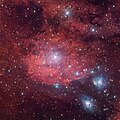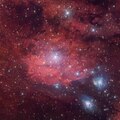Datei:IC1284 (NGC6589, NGC6590) - VST - Glowing rosy in the dark (potw2340a).jpg

Originaldatei (8.412 × 8.412 Pixel, Dateigröße: 23,64 MB, MIME-Typ: image/jpeg)
![]()
Diese Datei und die Informationen unter dem roten Trennstrich werden aus dem zentralen Medienarchiv Wikimedia Commons eingebunden.
Beschreibung
| BeschreibungIC1284 (NGC6589, NGC6590) - VST - Glowing rosy in the dark (potw2340a).jpg |
English: There are two different types of nebulae brought to you in this Picture of the Week. Each appears with a distinct colour in the visible sky and are captured here using the wide-field camera OmegaCAM on the VLT Survey Telescope (VST), hosted at ESO’s Paranal Observatory in the Chilean desert.The large, bright emission nebula at the centre, IC1284, is a star-forming region composed primarily of hydrogen. Its rosy glow comes from electrons within the hydrogen atoms: they’re excited by the radiation from young stars, but then they lose energy and emit a specific colour or wavelength of light. One of the filters on OmegaCAM lets through this particular reddish colour, hence the nebula’s look. Meanwhile, another colour filter highlights the blue reflection nebulae NGC6589 and NGC6590 in the lower right corner. The dust in a reflection nebula preferentially scatters shorter, bluer wavelengths of light from nearby stars, which is what gives these nebulae their eerie glow. It’s the same reason why the sky is blue!The frame of this image covers an area roughly equivalent in the sky to a full Moon. This image was captured as part of a large ESO public survey, the VST Photometric H alpha Survey of the Southern Galactic Plane and Bulge (VPHAS+), which observes nebulae and stars in visible light to help astronomers understand how stars are born, live and die. |
||
| Datum | 2. Oktober 2023 (Hochladedatum) | ||
| Quelle |
|
||
| Urheber | ESO/VPHAS+ team | ||
| Andere Versionen |
|
Lizenz
 |
This media was created by the European Southern Observatory (ESO).
Their website states: "Unless specifically noted, the images, videos, and music distributed on the public ESO website, along with the texts of press releases, announcements, pictures of the week, blog posts and captions, are licensed under a Creative Commons Attribution 4.0 International License, and may on a non-exclusive basis be reproduced without fee provided the credit is clear and visible." To the uploader: You must provide a link (URL) to the original file and the authorship information if available. |
Diese Datei ist lizenziert unter der Creative-Commons-Lizenz „Namensnennung 4.0 international“.
| |
Kurzbeschreibungen
image/jpeg
8.412 Pixel
8.412 Pixel
24.784.870 Byte
e085b520df4ab043cba7faf10ca28a08b3a7c9ea
2. Oktober 2023
pHash checksum Englisch
3rqmnicswnz3ai7vbwg2nmbdtonmjxsnjs17a80ya2cy9y87p5
Dateiversionen
Klicke auf einen Zeitpunkt, um diese Version zu laden.
| Version vom | Vorschaubild | Maße | Benutzer | Kommentar | |
|---|---|---|---|---|---|
| aktuell | 08:16, 2. Okt. 2023 |  | 8.412 × 8.412 (23,64 MB) | OptimusPrimeBot | #Spacemedia - Upload of https://www.eso.org/public/archives/images/large/potw2340a.jpg via Commons:Spacemedia |
Dateiverwendung
Die folgende Seite verwendet diese Datei:
Globale Dateiverwendung
Die nachfolgenden anderen Wikis verwenden diese Datei:
- Verwendung auf mk.wikipedia.org
Metadaten
Diese Datei enthält weitere Informationen (beispielsweise Exif-Metadaten), die in der Regel von der Digitalkamera oder dem verwendeten Scanner stammen. Durch nachträgliche Bearbeitung der Originaldatei können einige Details verändert worden sein.
| Namensnennung/Veröffentlicher | ESO/VPHAS+ team |
|---|---|
| Quelle | European Southern Observatory |
| Kurztitel |
|
| Bildtitel |
|
| Nutzungsbedingungen |
|
| Erfassungszeitpunkt | 06:00, 2. Okt. 2023 |
| JPEG-Dateikommentar | There are two different types of nebulae brought to you in this Picture of the Week. Each appears with a distinct colour in the visible sky and are captured here using the wide-field camera OmegaCAM on the VLT Survey Telescope (VST), hosted at ESO’s Paranal Observatory in the Chilean desert. The large, bright emission nebula at the centre, IC1284, is a star-forming region composed primarily of hydrogen. Its rosy glow comes from electrons within the hydrogen atoms: they’re excited by the radiation from young stars, but then they lose energy and emit a specific colour or wavelength of light. One of the filters on OmegaCAM lets through this particular reddish colour, hence the nebula’s look. Meanwhile, another colour filter highlights the blue reflection nebulae NGC6589 and NGC6590 in the lower right corner. The dust in a reflection nebula preferentially scatters shorter, bluer wavelengths of light from nearby stars, which is what gives these nebulae their eerie glow. It’s the same reason why the sky is blue! The frame of this image covers an area roughly equivalent in the sky to a full Moon. This image was captured as part of a large ESO public survey, the VST Photometric H alpha Survey of the Southern Galactic Plane and Bulge (VPHAS+), which observes nebulae and stars in visible light to help astronomers understand how stars are born, live and die. Links Explore the image in more detail in this video |
| Software | Adobe Photoshop 24.7 (Windows) |
| Speicherzeitpunkt | 16:25, 10. Aug. 2023 |
| Digitalisierungszeitpunkt | 13:04, 10. Jul. 2023 |
| Datum, zu dem die Metadaten letztmalig geändert wurden | 18:25, 10. Aug. 2023 |
| Eindeutige Kennung des ursprünglichen Dokuments | xmp.did:a775594b-325f-ce48-b19e-5c6606f56622 |
| Stichwörter | IC1284 |
| Kontaktinformationen |
Karl-Schwarzschild-Strasse 2 Garching bei München, None, D-85748 Germany |
| IIM-Version | 4 |
